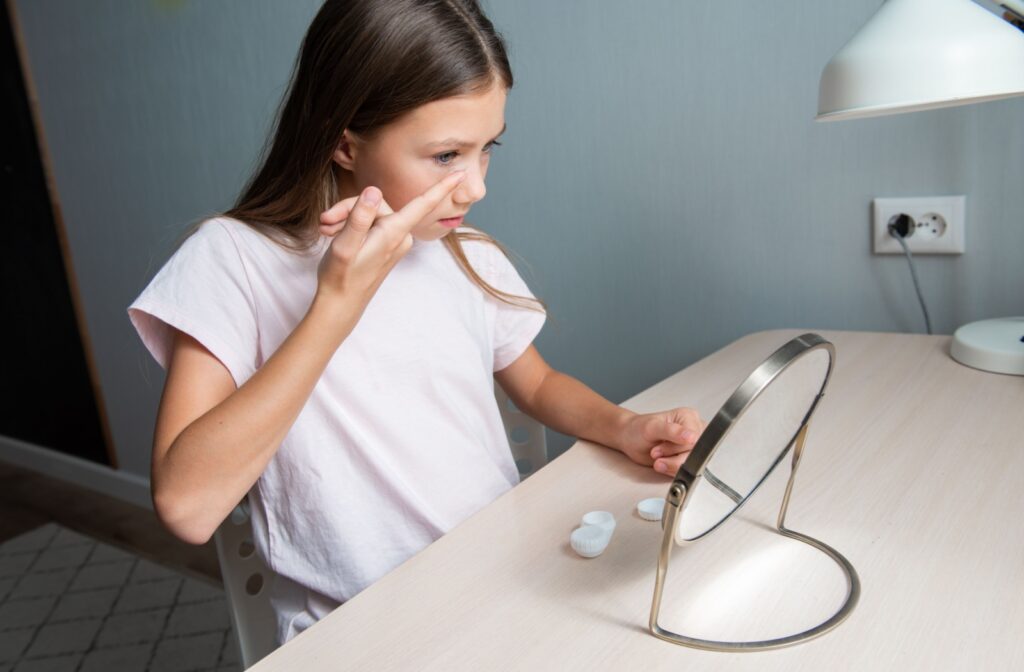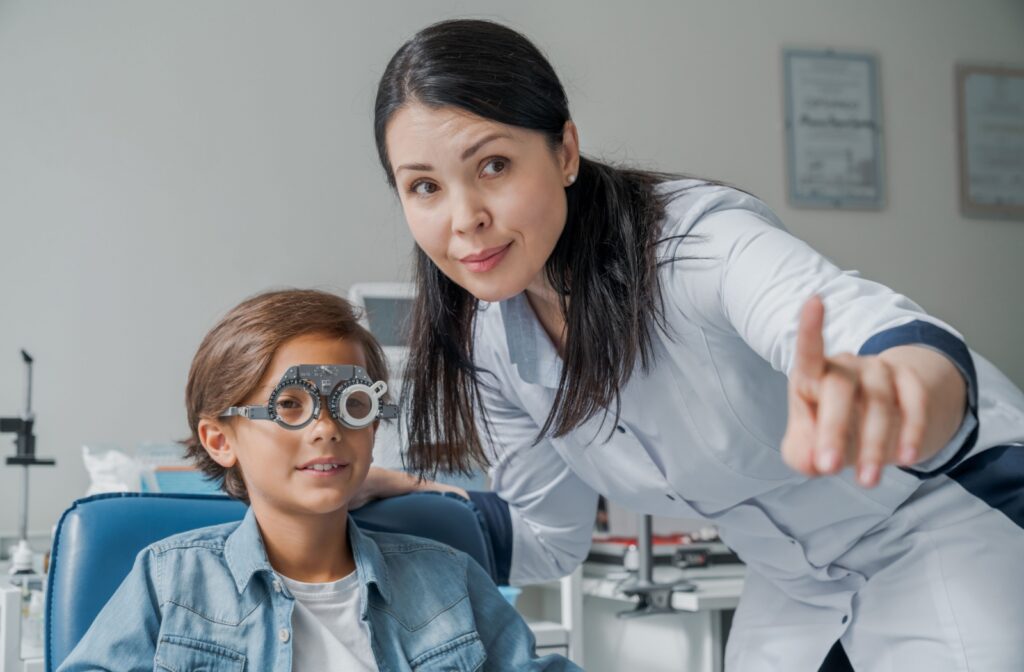You may notice your child squinting to see the TV or moving closer to the front of their classroom. These can be early signs of myopia, a common vision condition that affects many children today. As a parent, you want to do everything you can to support their vision and health for the future.
Learn about myopia, how it progresses, and the therapy options that can help support your child’s long-term eye health. You play an important role, and we’re here to guide you every step of the way.
What Is Myopia in Children?
Myopia, often called nearsightedness, is a refractive error that makes distant objects appear blurry while close-up objects typically remain clear. This happens when the eye grows slightly too long from front to back. As a result, light focuses in front of the retina instead of directly on it, causing that distant blur.
This condition often begins in childhood and can progress as your child grows, but the encouraging news is that myopia’s progression can be slowed. The physical elongation of the eye is what we aim to address with myopia management. It’s about more than just a stronger prescription each year; it’s about the health of the eye itself.
Signs of Myopia to Watch For
Children may not always tell you they’re having trouble with their vision because they might think what they see is normal. You can watch for subtle clues in their daily behavior. Let your eye doctor know if you notice any of these common signs in your child:
- Squinting to see distant objects
- Siting closer to the television or the front of the classroom
- Complaining of headaches or tired eyes
- Holding books or devices very close to their face
The Goal of Myopia Therapy and Management
Correcting your child’s blurry vision with glasses or contacts is an important first step so they can learn and play comfortably. However, the main goal of myopia therapy is to slow down its progression. The focus is on managing the rate at which their eyes change over time.
Why does slowing it down matter? By managing the rate of eye elongation during childhood, we can help lower the risk of developing sight-threatening conditions later in life. This proactive approach is a key part of modern pediatric eye care.
Common Vision Correction and Its Limits
Traditional glasses and contact lenses are excellent tools for providing clear vision. They help your child see the world clearly and participate fully in all their activities. However, it’s helpful to understand what these standard options do and do not do for myopia progression.
Single-Vision Glasses
Single-vision glasses are the most frequent starting point for children with myopia. They have one prescription power across the entire lens, which bends light so it focuses correctly on the retina for clear distance vision. While effective for clarity, they don’t typically include features designed to slow down the eye’s growth.
Traditional lenses focus central light on the retina, but they can cause peripheral light to focus behind the retina. The eye may then try to grow longer to “catch up” to this peripheral focus point. This can contribute to the progression of myopia over time.
Standard Contact Lenses
Standard soft contact lenses function much like single-vision glasses. They correct the refractive error directly on the eye’s surface, offering clear vision and a wider field of view. This freedom from frames is a great choice for many active kids and teens.
While they provide excellent visual correction, these conventional lenses generally do not address the underlying issue of eye elongation. They help a child see clearly today, but are not designed as a tool to manage future changes. This is where specific myopia therapies can offer a different approach.

Therapy Options to Discuss with an Eye Doctor
Today, you and your child have several effective options that can both correct vision and manage myopia progression. These therapies are designed with a dual purpose—to provide clear sight while sending signals to the eye to slow its growth. An eye doctor can help you decide which path fits your child’s needs and lifestyle.
Specialized Daytime Contact Lenses
These are not your average soft contacts—they are specially designed multifocal lenses for children with myopia. The lenses have different zones of focus built into them. The center part corrects blurry distance vision, while the outer parts change how light focuses on the peripheral retina to help slow eye growth.
Overnight Contact Lenses
Known as orthokeratology or ortho-k, this option involves wearing custom-designed rigid lenses only while your child sleeps. The lenses gently and temporarily reshape the cornea, the front surface of the eye. Your child removes them in the morning and can enjoy clear vision all day without needing glasses or contacts.
Prescription Eye Drops
A low-dose formulation of atropine eye drops is another therapy to consider. Used once a day, these drops work by relaxing the focusing mechanism of the eye, which can help slow down its elongation. With this approach, your child would still wear their regular glasses or contacts during the day to see clearly.
Support Your Child’s Vision Health
Professional care is just one piece of the puzzle. You can also incorporate simple habits into your family’s routine to support your child’s eye health. These proactive steps, combined with regular check-ups, create a comprehensive approach to managing myopia.
Regular Pediatric Eye Exams
Routine eye exams are the foundation of effective myopia management. They allow us to monitor changes in your child’s prescription and track the health of their eyes over time. This consistent monitoring helps us make informed decisions together about their care.
During these visits, we can discuss which therapy options may be a good fit for your child’s specific situation. Working with an eye doctor in Santa Cruz gives you a partner in your child’s visual health. We are here to answer your questions and provide tailored advice.
Encourage Outdoor Time
Studies show that spending time outdoors can play a positive role in a child’s visual development. Natural sunlight and looking at distant objects give their eyes a break from close-up work. Aim for at least 1–2 hours of outdoor play each day as a simple way to support their eyes.
Promote Frequent Screen Breaks
When your child is reading, doing homework, or using a digital device, their eyes are working hard. Encourage them to take frequent breaks to reduce eye strain. The 20-20-20 rule is an easy-to-remember guideline. Every 20 minutes, take a 20-second break to look at something 20 feet away.
Empower Your Child’s Vision with Confident Care
Managing your child’s myopia is a team effort, and you are the most important member of that team. With clear information and proactive care, you can help support your child’s vision for a lifetime of healthy sight. We believe in empowering you with the knowledge to make confident decisions.
If you have questions about myopia therapy or want to schedule an exam, our Total Vision Santa Cruz team is here to help. Contact us to book an appointment with an eye doctor in Santa Cruz and explore options for your child.



